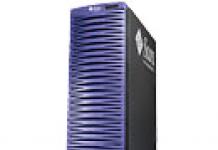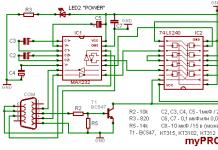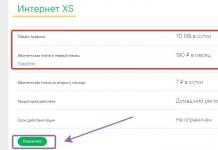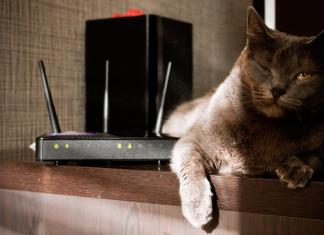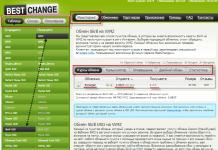My cat and I "dispersed" the twisted pair cable coming to the apartment a little
It is usually considered that the DSL "ceiling" is 20-30 Mbps, FTTB (optics to the building plus twisted pair to the apartment) is 100 Mbps, and PON supports speeds above 100 Mbps. My colleagues and I decided to dispel myths and "overclock" FTTB for a single provider.
The first thing we did was climb into the attic of the house. Already now, at least 1 Gbit / s comes to every house, and the house node has a suitable gigabit "copper" port. That is, we can simply take and switch any apartment where our cable lies to a suitable port and provide speeds of more 400 Mbps.
Actually, we have already done this as part of beta tests, and recently launched services in Moscow with new speeds for commercial operation. Yes, you can most likely connect.
What was that, cap?
Our backbone and metro networks have a free capacity reserve that significantly exceeds the needs of our customers even during the hours of the highest, maximum possible load. Take, for example, the New Year's holiday, beloved by me and the cat, in which those grandmothers who have already made friends with the Internet and Skype receive more congratulations.What is the difference with PON
The fact is that our FTTB network, which allows us to do all this, already exists. No modifications required. The cable is already entering your apartment. All wires are down. The optics go to the nodes in the houses. You just need to take and switch the cable to another port on the switch. Everything! Such a channel is already approaching you, but you did not know about it. And PON needs to be built - this is a new infrastructure throughout the city. There is another ambush - optical cores diverge from regional automatic telephone exchanges, which require proprietary client devices. And with us, with a regular FTTB network, you can use anything. Although there are few devices adapted for L2TP.How it works
A hefty transport canal comes from the main ring to the city level. Further along the city there are several large rings. From them - rings or mesh structures are smaller, "stars" are made at the level of the entrances. From the first level to the closet in the entrance, there are optical transport links. On the access layer switch, we will switch the cable to the gigabit port ... and that's it, we now have a gigabit link to the client.These are the results of my colleague without a cat, but with Wi-Fi (801.11 ac).
Technical capability
After I was able to test this at several points, we established such links for all employees of the company working on the project. Pretty fast, I must say. There are almost no technical restrictions: the only thing is that there are literally a couple of dozen blocks in Moscow where it is necessary to slightly modernize the equipment, but we are already working on it.More restrictions
You will laugh, but we have not found a way to utilize such speeds. So, it turned out that such a channel can only be clogged with very specific tasks - this is either CCTV from a bunch of cameras, or HD video for all family members at the same time, or the task of a photographer who uploads pictures somewhere. Also - network drives. In general, with the exception of torrents, this is the provider's dream: once a day, the client makes a "blast" with a heavy file and is wildly happy.But a number of other things arose that directly relate to marketing. First, almost all resources send content much slower than the channel allows. This is an eternal problem "why my Internet slows down, and the tests show normal speed." Because you need resources that can provide a large number of customers with content delivery at high speed. So someone will have to give up their illusions, not every resource meets these requirements.
100Mbps is already very fast for Internet connections for the vast majority of users. Even higher speeds may be required by those who are forced to work with very large files.

Everything in this photo is correct, including the router.
The link must fit a desktop or laptop with copper - Wi-Fi, especially in conditions of interference from other networks, it simply will not allow the channel to be distributed at such a speed. Therefore, the best option is a desktop on a cable, tablets and phones - by air.
The end devices themselves can also cut traffic. Naturally, you must have a 400 Mbps device (router or network card). In the beta, however, a couple of surprises were revealed with the fact that not all devices can actually hold such traffic, despite the statements about it.
Tests
This is where the fun begins. We took 10 high-performance devices with L2TP support.Gigabit is fast, especially for home use, so routers must be appropriate. I will say right away that it was not possible to cover all the models and quickly test them, so we focused on support for gigabit connection, dual-band Wi-Fi and good feedback from users.
Our shortlist:
Asus RT-68U
D-Link DIR 825 D1
Pre-sale sample from the new manufacturer Totolink
Zyxel Keenetic Ultra
Apple Air port Time capsule
As soon as I tested the devices against our checklists in the office, it was time to test the devices in the field, here you can evaluate the real performance of the device.
For this action, I tried to prepare thoroughly, took a MacBook Pro 15 retina (late 2012) - the main working laptop, plugged a 128GB SSD into a separate desktop and connected the Asus PCE-AC68 Wi-Fi adapter there to the heap so that nothing would interfere with overclocking, just took USB Wi-Fi adapter Totolink A2000UA with support for 802.11ac just in case. In addition, I captured the iPad mini, iPhone 5 and Samsung Galaxy note - we will test Wi-Fi on them.
To check the speed, in addition to the usual resources, such as - speedtest, file downloads, I installed Iperf on one of our servers connected via a gigabit link to our core network. It seems that everything turned out something like this:

A little about the test methodology
In many reviews of routers that I have seen, stands are usually assembled with programs for generating traffic. We decided to do something differently: to conduct testing the way a subscriber will do it, checking the speed of our Internet access.The main tools were:
1) Speedtest.net - nowhere without it
2) Mirror.yandex.ru
3) Iperf - some synthetics
4) Youtube
The list is small, but on these resources you can estimate how fast Internet access works, so to speak, a natural product and no synthetics.
Let's start testing
First, let's see which of the Wi-Fi networks are already nearby.
"People's" 2.4GHz band - neither more nor less

5GHz - we even got here, but there are not so many networks, two of them are ours
Asus RT-68U

Top router from Asus. The filling of the device inspires respect: a chip from Broadcom BCM4708A, 256MB RAM, 128MB Flash, support for 802.11ac and Beamforming is present.
Patch cord: speed test showed 224Mbps for upload and 196Mbps for Upload 
Good result, we continue to test, next in line is Iperf.

On this test, the unexpected happened. Either the router started to "glitch", or iperf, but the results did not rise above 50Mbps. It's okay, let's look at a more vital test - downloading a file from Yandex.

Almost 35MB per second!
I ran the tests a few more times, then decided to clean the SSD, at such speeds it quickly clogged.
Now let's take a look at how fast Wi-Fi works. The wireless network is capricious, and many factors can affect the final performance. The laptop was located 4 meters from the router in a straight line.
The speed test showed almost 165Mbps on Download and 166 on Upload. Worthy! Especially when it comes to the 2.4GHz band


Iperf showed similar values:

Let's switch now to 5GHz. Since my router can handle 802.11ac, but my work Macbook doesn’t, I plugged in an external 802.11ac 2x2 adapter.

The connection was successful ... Let's take a look at the speed test:

209Mbps on Download 111 on Upload, most likely 210Mbps is the current ceiling for L2TP router performance. Let's hope that in the new firmware Asus will fix this.
Iperf showed the results even lower:

D-Link Dir 825 D1

The next in line is the representative of the middle price range D-Link DIR825. The router is equipped with a Dual-Band Wi-Fi module, which is currently a rarity for the mid-range. Let's see what this router is capable of.
Patch cord connection


Let's move on to testing the Wi-Fi network. The router has two Airgain antennas, so I expect high speeds over Wi-Fi.
For a network operating in the 2.4GHz band:

This frequency is maximally loaded, so such a result was, in principle, expected. How will 5GHz prove itself?


130-150Mbps. With a detailed tinkering of the settings, it turned out that if you disable encryption of the Wi-Fi network, performance increases. Of course, I did not discover America, but I did not deduce such a pattern on other routers.
Moving on to the next test subject - Totolink
This router has similar characteristics to the D-Link DIR 825, they are built on the same SoC - RTL8197D, but the radio module in this router supports 802.11ac. It will be interesting to evaluate its capabilities in real conditions.Patch cord: 
Eh ... okay, no comment.

Getting closer to reality.
To be honest, I did not think that the "old man" RTL8197D is capable of pumping through itself in L2TP at such speeds. This makes the test results of the Wi-Fi network more interesting.
"People's" frequency - 2.4GHz


Both speedtest and iperf showed almost identical results.
At 5GHz, the speed should generally be prohibitive! Maybe…
But no, although the connection showed that the connection was established at a speed of 867Mbps.

Iperf is trying to lower it to the ground, and it is not bad at it.

Our last participant in the marathon - Zyxel Keenetic Ultra

Popular model among L2TP devices. It accelerates well and works stably. We connect the patch cord and run the speed test:


And I download the Fedora distribution kit, which has already become native, for the duration of the tests:
Unfortunately, this model from Zyxel does not support 802.11ac, so I will be content with 802.11n. Let's get started!


Let's look at 5GHz


Neither less nor less is the standard. This situation did not suit me, and I decided to connect a new Time Capsule with 802.11ac support (very conditional for the PCT model) to the router.

Here! It is a pity that manufacturers do not bundle timecapsula with their routers.
And if you measure the speed on your phone / tablet?
Most users, especially those who are not familiar with the methodologies of various performance tests, and simply run the application on their phone. I'll do that too.
There was an iPhone, a tablet and an Android phone. It makes no sense to test the connection on each router, so I settled on the latest router model.


For 2.4GHz and 5GHz, respectively, here we hit the performance ceiling of the Wi-Fi module on the phone. Devices on android showed about the same results, while on a tablet this speed was obtained when connected to a network at 5GHz, at 2.4GHz it will most likely be lower:


Well, tests on the street:

What happened?
The process of testing the new service fascinated me with the cat, so in the end we tested 10 routers from different manufacturers, price categories with different "stuffing". Here are the most interesting ones:- Zyxel Keenetic Ultra
- D-Link DIR825
- Toto-Link
- Asus RT-68U
- Zyxel Keenetic Giga II
- TP-Link Archer C7 v.1
- D-Link DIR 850L
- Buffalo WZR-1759DHP
- Netgear R7000 "Highthawk"
- Arcadian
Price
The service is new, the description will appear on the site in a couple of days. The cost is 1850 rubles per month, if without our router.UPD, as requested in the comments:
| Asus RT-68U | D-Link DIR 825 D1 | Toto-Link | Zyxel Keenetic Ultra | ||||
| By cable (WAN-LAN) | |||||||
| Speedtest | D: 224.2 Mbps U: 196.77 Mbps |
D: 352.16 Mbps U: 370.3 Mbps | D: 462.6 Mbps U: 255.8 Mbps | D: 408.22 Mbps U: 275.59 Mbps | |||
| Iperf | 26.3Mbps | 354 Mbps | 379 Mbps | ~ 35MB / s | ~ 43 MB / s | ~ 50MB / s | ~ 52MB / s |
| Wi-Fi 2.4GHz | |||||||
| Speedtest | D: 164.53 Mbps U: 165.68 Mbps | D: 86.72 Mbps U: 57.82 Mbps | D: 155.01 Mbps U: 118.62 Mbps | D: 131.57 Mbps U: 113.53 Mbps | |||
| Iperf | 140Mbps | 52.5 Mbps | 152Mbps | 132 Mbps | |||
| Wi-Fi 5GHz | |||||||
| Speedtest | D: 209.4 Mbps U: 111.38 Mbps | D: 148.27 Mbps U: 149.45 Mbps | D: 233 Mbps U: 132.76 Mbps | D: 185.4 Mbps U: 181.07 Mbps | |||
| Iperf | 163Mbps | 130 Mbps | 192 Mbps | 171 Mbps |
ISPs offering wired Internet use different strategies in the race to market leadership. Many of them follow their usual path: they reduce the cost of tariffs, improve equipment, and provide support for local media resources with free content. But there are also providers who are trying to conquer their place in the sun with ambitious chips such as the delivery of high-speed Internet - connections with speeds exceeding 100 Mbps. In some CIS countries (for example, in Kazakhstan), it is still rare to find the Internet speed offered by providers above 150 Mbit / s. But on the websites of Internet providers in Russia, Ukraine and Belarus, offers in the form of tariff plans with speeds of 200, 300, 500 and even 1000 Mbps are not uncommon. High-speed tariff plans are more expensive than regular ones, which usually promise unlimited traffic and speeds up to 100 Mbps. The cost of high-speed tariffs is higher than normal tariffs, however, the prices are not directly proportional to the rate of increase in speed. For a tariff with a speed of 200 Mbit / s, providers ask for the cost of a speed of 100 Mbit / s with an average mark-up of 30-40%. And in promotional rates, which need to be urgently switched to such and such a date, otherwise the chance will be missed, the margin may be even less. What is the secret of such generosity? Is it all explained by the “cheaper big package” strategy? Below we will consider the pitfalls of high-speed tariffs.
1. Why do you need an Internet speed of more than 100 Mbps?
The high speed of the Internet - more than 100 Mbit / s - is not relevant in every case. A tariff plan with a speed of 100 Mbps will be enough for comfortable web surfing, online games, watching IP-TV or video on the Internet, including in HD quality. Problems can arise only in the case of a Wi-Fi connection of such a number of devices, in which the router begins to greatly reduce the speed for each of the home network users. For an average router, this is usually more than 10 devices (including TVs, refrigerators and other Smart House equipment).
An Internet speed of more than 100 Mbit / s makes sense only when downloading weighty files to a computer - distributions of operating systems or other software, high-quality video, audio collections, etc. Only with constant downloading of large file sizes can the payment for a high-speed Internet connection be justified. For example, if members of the whole family in the evenings at the same time actively download files from torrent trackers and file storages. But even then we are talking only about those tariff plans, the speed of which, due to technical reasons, can be used on computer and mobile devices in the house. Indeed, in order to unleash the potential of a high-speed tariff plan, it is necessary to have equipment in the house that would, in fact, ensure the disclosure of this potential. And not even all modern technology is tailored for the possibility of using high Internet speeds.
2. Capabilities of hard drives
The potential of a tariff with an Internet speed of more than 200 Mbit / s may not be revealed if the computer does not have an SSD, but an ordinary HDD - a hard disk with magnetic platters. When websites are opened in a browser window, their data is written to the cache, that is, downloaded to the computer disk. The browser cache consists of several small files, the read and write speed of which on the HDD, as a rule, does not even reach 1 Mb / s (8 Mb / s). Speed from 80 to 170 Mb / s (respectively, from 640 to 1360 Mb / s) HDDs can only develop with sequential file recording, that is, when downloading single large files from the Internet. But this is the maximum indicator that can be achieved only in certain areas (at the outer edge of the plate, where there are more tracks, which, accordingly, have more sectors). When recording large files, the average data writing speed may be even less than half of the maximum possible HDD speed.
Not only HDDs, but not even every SSD-disk will be able to unleash the potential of the tariff with an Internet speed of more than 700 Mbps. If we talk about the 1000 Mbit / s tariff, then even if you have a computer with a productive SSD, it makes sense to pay for such a tariff, if only there is a router in the house and access to the Internet is carried out from several devices.
3. Bandwidth of the router
The "correct" providers in the description of tariff plans on their websites honestly warn that the offered high speeds can be obtained only in conditions of direct connection - when the provider's cable is connected to the Ethernet port of a PC or laptop. The fact is that home routers not only cut the speed by distributing it between devices connected to the network, they are also limited by a bandwidth of 300 Mbps. This is the maximum speed that a budget router can theoretically handle. To use a tariff plan with an Internet speed of 1000 Mbps, you need to purchase a special powerful router with support for the corresponding speed indicator. And such routers are much more expensive than simple models.
It is also necessary to understand that in conditions of work with maximum load, the resource of the router will be depleted faster.
4. Network card
Like a router, a network card can be a high speed Internet connection. Older network cards, for example, can only support a maximum data transfer rate of 100 Mbps. In this case, you will have to upgrade your PC and replace the network card with a modern one with higher bandwidth.
5. Wi-Fi module
With a Wi-Fi module built into a laptop or as part of a PC, the picture is the same as with a network card. Budget notebook assemblies can be equipped with Wi-Fi modules with a bandwidth of up to 150 Mbps. And old network cards with Wi-Fi for PCs, connected via the PCI interface, are completely limited by the speed of the 802.11a standard - up to 54 Mbps. In this case, the Wi-Fi module will have to be replaced. Or, specifically to work with a high-speed tariff plan, purchase a Wi-Fi module that connects to a USB port.
6. Weak processor
The processor, to a lesser extent than the above devices, can negatively affect the speed of Internet delivery. Nevertheless, this is the "heart" of the computer, and to some extent it will depend on how quickly data is written to or read from the hard disk. So if we are talking about purchasing a high-speed tariff plan, a weak computer processor will need to be replaced with a more productive one. And this is a rather considerable financial cost, especially if the processor has to be changed along with the motherboard. If the laptop does not support the replacement of the processor, it will need to be sold and purchased a new one with more powerful hardware.
7. Summing up: is it worth switching to high-speed tariffs?

The Internet with a speed higher than 200 Mbit / s can not be considered as an urgent need of society yet. If not to ensure an acceptable speed for each of the users of small offices, hostels, cafes, gas stations, and other public places, switching to an expensive tariff plan can be a waste of money. Fast access to sites is also provided within the tariff with speeds up to 100 Mbit / s. If we are dealing with a slow server, no high-speed tariff will help here. It's easier to contact the site owner with a request to upgrade the equipment. A high-speed tariff may not always be able to ensure the promptness of downloading files from the Internet. For example, the high speed of the Internet on the current computer will in no way solve the problem of the download time of the file via the torrent in the conditions of the low speed of the Internet at the distributing seed (or its deliberate limitation in the settings of the torrent client).
ISPs often use the delivery of high-speed rates as a marketing ploy to attract customers. More precisely, to beat them off from competitors. It is very good if the provider's website, when describing tariffs, specifies specific technical requirements for devices that will participate in the process of ensuring high Internet speed (in fact, what was mentioned above).
It is important to take into account that providers prescribe the wording “up to such and such speed” in tariff plans, for example, “up to 300 Mbps”. The speeds indicated by providers in tariff plans are, as a rule, the maximum rates achieved under certain conditions. For example, not during peak hours, when the provider's channel is not congested. If, nevertheless, a decision is made to switch to a high-speed tariff plan, it is necessary to check with the provider the real Internet speed, in particular, how much it usually decreases during peak hours.
Our today's article is for the most active Internet users who do not have enough traffic included in the tariff plan or service. How to connect additional megabytes or gigabytes on Tele2 so as not to be left without Internet access at the most inopportune moment? Let's find out!
In the table below you can see how to get additional megabytes on Tele2, as well as the conditions for these options.
- Volume - 500 MB (day) - 50 rubles: connect - * 155 * 171 # , disable - * 155 * 170 # ;
- Volume - 100 MB (day) - 15 rubles: connect - * 155 * 281 # , disable - * 155 * 280 # ;
Read about that in another article.
Gigabytes (until the end of the month)
Let's start with how to get additional gigabytes on Tele2, if the bulk of the Internet is provided to the tariff plan of the "My" line.
You can add 1 GB to these Tele2 tariffs, but - five times in a row. The cost of such an option is 100 rubles, the command for activation is * 155 * 24 * 3 * 0 # , shutdown - * 155 * 24 * 3 # .
An important feature for those who decide to take additional internet traffic in addition to the basic package. Next month it will be added to your tariff, exactly the same as the subscription fee for using it. Thus, if you do not want to increase the number of provided gigabytes on a permanent basis, the option must be disabled in a timely manner. 
You can connect additional GB on Tele2 when the traffic provided according to the terms of the Internet services of this cellular operator, those that usually connect to the Internet for Devices tariff plan and are used in modems and tablets, runs out.
How to add gigabytes on Tele2 and how much it will cost - look:
- Volume - 3 GB (until the end of the month) - 150 rubles: connect - * 155 * 181 # , disable - * 155 * 180 # ;
- Volume - 5 GB (until the end of the month) - 250 rubles: connect - * 155 * 231 # , disable - * 155 * 230 # ;
And now about another similar service - "Auto-renewal". She will connect. when the bulk of Internet traffic comes to an end, and will add 500 MB. Connection - * 155 * 311 # ... Disconnection - * 155 * 310 # ... The cost is 50 rubles. Works with Tele2 Internet services.
All prices are for Moscow and the Moscow region. The cost of services in the regions may differ, so we have compiled another table so that you can compare the conditions for different cities.
| 100 Mb | 500 MB | 125 MB | 150 MB | 1 GB | 3 GB | 5 GB | 10 GB | |
| Moscow | 15 p. | 50 p. | - | - | 100 p. | 150 p. | 250 p. | - |
| Saint Petersburg | 12 p. | 50 p. | - | - | 125 p. | 240 p. | - | - |
| Nizhny Novgorod | - | 50 p. | 10 p. | - | 100 p. | 150 p. | - | 300 p. |
| Tula | 0 p. | 60 p. | - | - | - | 130 p. | 200 p. | |
| Novosibirsk | 12 p. | 50 p. | - | - | 100 p. | 200 p. | - | - |
| Samara | 8 p. | 50 p. | - | - | 100 p. | 180 p. | - | - |
| Kirov | 10 p. | 50 p. | - | - | 100 p. | 190 p. | - | - |
| Volgograd | - | 50 p. | - | 10 p. | 100 p. | 190 p. | - | - |
| Kazan | 10 p. | 50 p. | - | - | 100 p. | 150 p. | - | - |
| Cheboksary | 7 p. | 50 p. | - | - | 100 p. | 170 p. | - | - |
And finally, Tele2 subscribers are often interested in, for example, a friend, if he has run out of Internet traffic. We answer - definitely, this cannot be done, but you can use the Tele2 "Mobile Transfer" service and send a certain amount to your friend so that he can independently connect the Internet service to his number.



